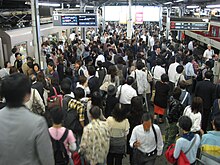Kinki Nippon Tetsudo
Kinki Nippon Tetsudō KK ( Japanese 近畿 日本 鉄 道 株式会社 , Kinki Nippon Tetsudō Kabushiki-gaisha ; short: 近 鉄 , Kintetsu ; English Kintetsu Corporation ) is the largest private railway company in Japan, which has its own rail system and primarily in the Kansai -Region ( Kinki ) operated. The route network extends over all relevant industrial cities such as B. Osaka , Kyōto or Nagoya .
Companies
The Kintetsu Group, managed by Kinki Nippon Tetsudō, employs 8,500 people and has 135 subsidiaries with equity of 92.7 billion yen. In addition to the traditional business as one of the large Japanese private railway companies, the group operates real estate business, hotels, tourism, retail stores ( Depāto ; including Kinsho (Kintetsu Shop) located directly in / at train stations ) - Kintetsu Hyakkaten ( 近 鉄 百貨店 ) - and telecommunications. This recently achieved a turnover of 948 billion yen.
Railway network
The group operates a rail network over 582.3 kilometers with 333 stations, both underground (e.g. Namba ( Osaka )) and above ground (e.g. Yamato-Saidaiji ( Nara )), as well as an elevated railway (e.g. . Turmbahnhof Tsuruhashi (Osaka)), which it uses 1970 trains. Kintetsu handles over 610 million passengers annually. Transitions to the important competitors in the Kinki region (for example Hankyū , Hanshin , JR or the subways in the target cities) are guaranteed, partly in coordination with the timetable.
The track network is made up of various types of train such as Local (stops between the start and destination station at each station), Semi-Express (stops at transport hubs and selected stations), Express (stops at transport hubs), Rapid Express (stops at important transport hubs) or Limited -Express ( Urban-Liner ; travels between cities without stopping, stops at the main transport hubs in the start and destination city) used in parallel. Since the track network between stations is usually laid out on two tracks, the slower trains wait in selected four- or multi-track stations for the faster trains to overtake.
The RFID payment card ICOCA , which is widespread in western Japan and especially in the Kinki region , as well as the RFID-based PiTaPa is supported by at least one specially marked ticket barrier at every entrance at all train stations.
Stock exchange listing
The company's shares are traded on the first division of the stock exchange in Tokyo, Osaka and Nagoya.
Subsidiaries
- Kintetsu World Express (Air Freight)
- Kinki Sharyō (rail vehicle construction)
Web links
- Official Website (Japanese)
- Kintetsu Corporation (English)



